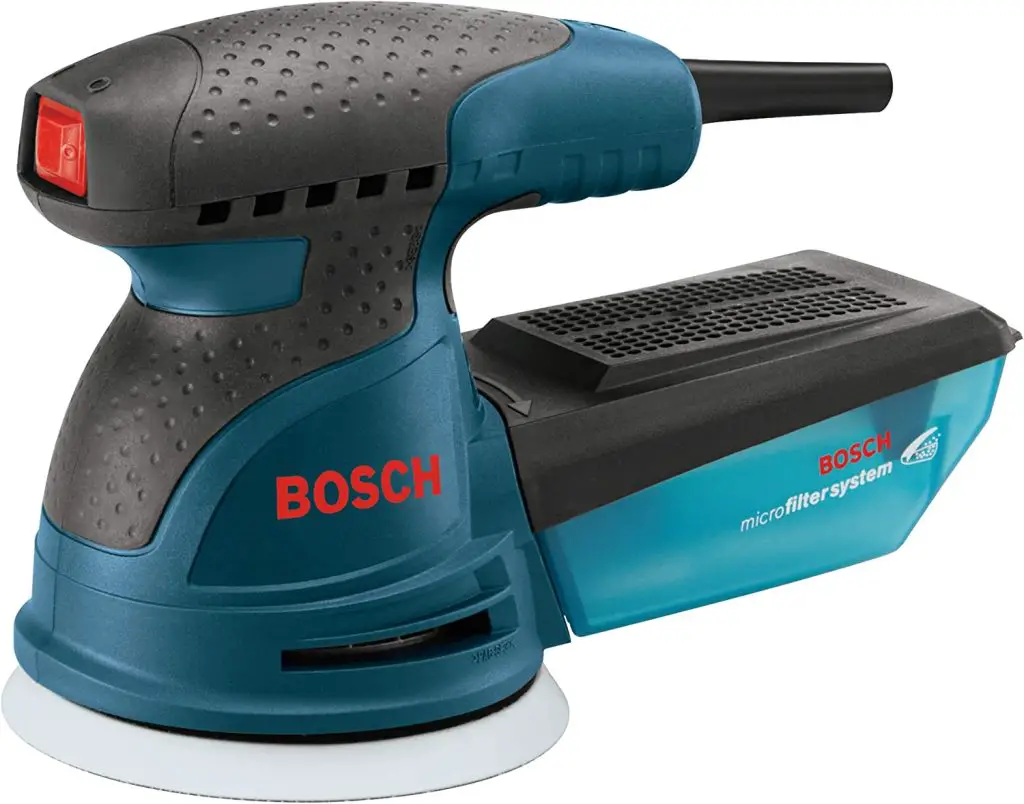Woodworking is a craft that requires precision and finesse, and having the right tools can make all the difference in achieving professional-quality results. One such tool that every woodworker should have in their arsenal is an orbit sander.
What Is an Orbit Sander?
An orbit sander is a type of power sander used for smoothing wood, plastic, metal, or drywall surfaces with sandpaper or other abrasives. It was invented in the early 1900s by a man named James H. Macpherson and was used in the manufacturing of ship propellers.
In this article, we will delve into the world of orbit sanders, exploring what they are, how they work, and why they are valuable assets for woodworking projects.
See Also: Best Orbit Sander
What Is an Orbit Sander? – Detailed Guide
An orbit sander, also known as a random orbital sander, is a power tool used for sanding wood, metal, and other materials.
Unlike a belt sander that moves in a linear motion, an orbit sander combines both rotary and orbital movements to create a random sanding pattern.
This unique motion reduces the risk of leaving swirl marks on the work surface, making it a popular choice among woodworkers.
How Does an Orbit Sander Work?
An orbit sander consists of a motor, a sanding pad, and a dust collection system. The motor drives the sanding pad in an orbital motion while simultaneously rotating it.
The combination of these two movements ensures that the sanding pad doesn’t follow a predictable pattern, thus minimizing the risk of creating visible marks on the work surface.
The sanding pad of an orbit sander typically uses hook-and-loop fastening, commonly known as Velcro, to attach sandpaper discs.
This system allows for quick and easy replacement of sandpaper, ensuring uninterrupted workflow during sanding projects.
How to Use Orbit Sander?
Orbit sanders are a type of power tool used to smooth wood, metal, or other surfaces. To use an orbital sander properly, follow these steps:
- Put on safety glasses and a dust mask.
- Vacuum the surface to be sanded to remove any debris.
- Connect the sander to a power source.
- Select the appropriate sanding disk for the desired finish.
- Apply light pressure and keep the sander in motion, sanding the surface in a back-and-forth motion until it is smooth.
- Vacuum the surface once more to remove any dust created by sanding.
- Disconnect the sander from the power source and store it away.
Advantages of Using an Orbit Sander
- Versatility
Orbit sanders are versatile tools that can be used for various tasks. They are effective for both rough sanding and fine finishing, making them suitable for a wide range of woodworking projects.
- Reduced Sanding Marks
The random sanding pattern created by an orbit sander helps to eliminate swirl marks, ensuring a smooth and uniform finish on the work surface.
- Efficient Material Removal
With their powerful motor and fast sanding action, orbit sanders excel at removing material quickly and efficiently.
This makes them ideal for tasks such as sanding large surfaces or removing paint and varnish.
- Dust Collection
Many modern orbit sanders come equipped with a dust collection system, either in the form of a built-in dust bag or a connection point for a vacuum cleaner.
This feature helps to keep the work area clean and minimizes the amount of airborne dust, promoting a healthier and safer working environment.
- Ergonomics
Orbit sanders are designed with user comfort in mind. They typically feature ergonomic handles and lightweight construction, reducing fatigue and allowing for extended periods of sanding without discomfort.

BOSCH ROS20VSC Orbital Sander
The BOSCH ROS20VSC Orbit Sander is a fantastic tool for any woodworking enthusiast.
With its 2.5 Amp motor and 5-inch sanding pad, it delivers power and precision for a smooth finish.
Get ready to take your sanding and polishing game to the next level with this versatile sander! “See IT“
Tips for Using an Orbit Sander Effectively
- Select the Right Grit
Different sanding tasks require different grits of sandpaper. Coarser grits, such as 80 or 120, are suitable for removing material quickly.
Finer grits, such as 220 or 320, are ideal for achieving a smooth finish. It’s important to choose the appropriate grit for the task at hand to achieve the desired results.
- Start Slowly
When starting a sanding project, begin with a low-speed setting and gradually increase the speed as needed. This allows for better control and reduces the risk of damaging the workpiece.
- Keep the Sander in Motion
To avoid leaving sanding marks, always keep the sander moving while in contact with the work surface.
Holding the sander in one spot for too long can cause uneven sanding or even create depressions in the material.
- Use Proper Pressure
Apply even pressure on the sander while sanding, but avoid pressing too hard. Let the weight of the sander do most of the work.
Excessive pressure can lead to uneven sanding or damage to the surface. Find the right balance between applying enough pressure to keep the sandpaper in contact with the material and allowing the sander to glide smoothly.
- Sand in Stages
For optimal results, it’s often necessary to sand in multiple stages, starting with a coarser grit and gradually progressing to finer grits.
This approach helps to remove imperfections, smooth out the surface, and achieve a polished finish.
Remember to clean the work area between stages to remove any residual dust and debris.
Safety Precautions
- Eye and Respiratory Protection
When using an orbit sander, wear safety goggles to protect your eyes from flying debris. Additionally, use a dust mask or respirator to prevent inhalation of fine particles.
- Secure Workpiece
Always secure the workpiece firmly before sanding to prevent it from moving or slipping during the process. This ensures stability and reduces the risk of accidents or injuries.
- Proper Ventilation
If you’re working in an enclosed space, ensure proper ventilation to prevent the buildup of dust and fumes. Open windows or use exhaust fans to maintain a clean and breathable environment.
- Disconnect Power
Before changing sandpaper or performing any maintenance tasks on the sander, disconnect it from the power source to avoid accidental start-ups and potential injuries.
Conclusion
What is an orbital sander used for? An orbit sander represents a great tool for tackling many woodworking projects. It has the power to deliver superior results with its fast-action sanding motion and is also easy to use and maintain.
However, no matter the power of its action, an orbit sander succeeds only when used with precision and technique.
With thoughtful planning and practice, you can be sure your projects will be delightfully smooth and sanded to perfection.
I hope this blog post is helpful for you in understanding what is an orbit sander.
Read Also: What Is Orbital Sander Used For?
